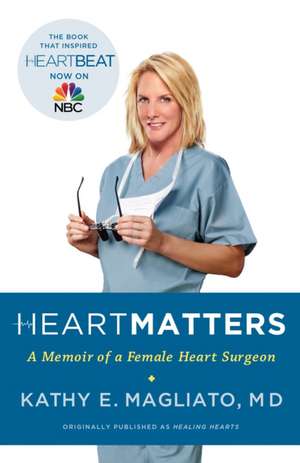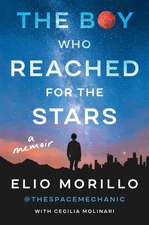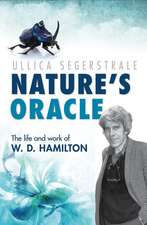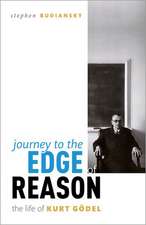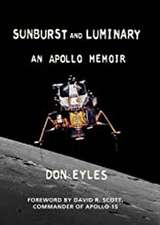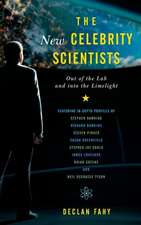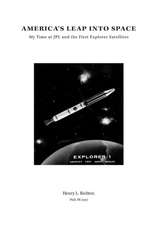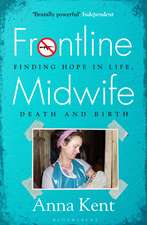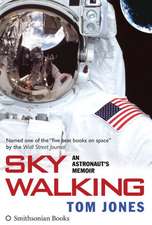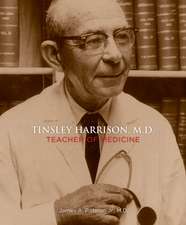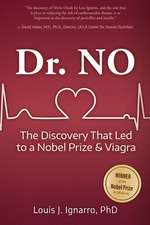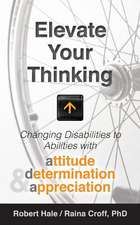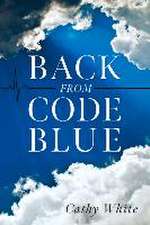Heart Matters: A Memoir of a Female Heart Surgeon
Autor Kathy E. Magliatoen Limba Engleză Paperback – 31 dec 2010
Dr. Kathy Magliato is one of the few female heart surgeons practicing in the world today. She is also a member of an even more exclusive group—those surgeons specially trained to perform heart transplants. Healing Hearts is the story of the making of a surgeon who is also a wife and mother. Dr. Magliato takes us into her highly demanding, physically intense, male-dominated world and shows us how she masterfully works to save patients’ lives every day.
In her memoir, we come to know many of those patients whose lives Dr. Magliato has touched: a baby born with a hole in her heart, a ninety-four-year-old woman with a lethal tear in her aorta, and a thirty-five-year-old movie producer who saves her own life by recognizing the symptoms of a heart attack. Along the way, Dr. Magliato sheds light on the too often unrecognized symptoms of a heart attack and cardiovascular disease—the number one killer of women in America—and the specific measures that can be taken to prevent it.
As we begin to see what it takes for Dr. Magliato to heal hearts day after day, we come to understand a more human side of the medical profession. Dr. Magliato celebrates with her patients when they overcome their disease and personally mourns when they die as a result of it. She understands deeply the pain and suffering that heart disease can wreak on patients as well as on their families. Healing Hearts is not only her story, it is also the story of everyone affected by heart disease—roughly one in three Americans.
Dr. Magliato acquaints us with the day-to-day realities of her life and work. We see her skillfully juggle a full and happy family life as the wife of a liver transplant surgeon (they have bedside tables cluttered with pagers and cell phones that ring throughout the night) and the mother of two young boys. We also see the toll that being a female pioneer can take, as well as the rewards of such demanding work. She, like many working women, is striving to have it all.
Dr. Magliato’s powerful and moving memoir demonstrates her passion and commitment to her family, her patients, and her profession and reveals that, at the end of a long day, it’s our hearts that matter most.
Kathy E. Magliato, MD, is currently the director of women’s cardiac services at Saint John’s Health Center in Santa Monica, California, and an attending cardiothoracic surgeon at Torrance Memorial Medical Center in Torrance, California, where she is developing a women’s heart center to address the cardiac needs of female patients. She lives in Pacific Palisades with her husband and their two children.
From the Hardcover edition.
Preț: 92.27 lei
Nou
Puncte Express: 138
Preț estimativ în valută:
17.66€ • 18.37$ • 14.58£
17.66€ • 18.37$ • 14.58£
Carte în stoc
Livrare din stoc 05 martie
Preluare comenzi: 021 569.72.76
Specificații
ISBN-13: 9780767930277
ISBN-10: 0767930274
Pagini: 261
Dimensiuni: 131 x 204 x 16 mm
Greutate: 0.2 kg
Editura: Three Rivers Press (CA)
ISBN-10: 0767930274
Pagini: 261
Dimensiuni: 131 x 204 x 16 mm
Greutate: 0.2 kg
Editura: Three Rivers Press (CA)
Notă biografică
Kathy E. Magliato, MD, is currently the director of women’s cardiac services at Saint John’s Health Center in Santa Monica, California, and an attending cardiothoracic surgeon at Torrance Memorial Medical Center in Torrance, California, where she is developing a women’s heart center to address the cardiac needs of female patients. She lives in Pacific Palisades with her husband and their two children.
From the Hardcover edition.
From the Hardcover edition.
Extras
Chapter 1: Every Sixty Seconds
MAT: MAGLIATO-ADJUSTED TIME. IT’S GREENWICH MEAN time adjusted for the atomic clock plus twenty minutes. Which means it’s your time plus twenty minutes. It’s the clock I run on except, of course, when it’s an emergency. Then I am there in a heartbeat (pun intended). Otherwise, it’s whatever time you say you want me there—for dinner, for a playdate with the kids, for an eyebrow waxing—plus twenty minutes. And don’t roll your eyes at me when I get there. You’re lucky that I even showed up at all.
• • •
It was a still spring morning. The kind of morning that makes you yearn to be lazy. To languish in the comfort of your home while sipping coffee outside and smelling the morning ocean breeze of the Palisades, salt mixed with night- blooming jasmine. How I wish I could be lazy. Just once. When my alarm clock goes off at 5:03 a.m. (I always set it for an odd number), it’s like a starter pistol for my day—assuming I ever went to sleep in the first place.
So I found myself that morning running on MAT. I desperately wanted to drop my son at school so I could maintain at least some semblance of motherhood. We were running late by everyone else’s standards—twenty minutes late. I was surrounded by signs of road rage everywhere as I was trying to make my way safely to Nicholas’s school. Everyone was on a cell phone, everyone was blowing a horn in a cacophony of rage, everyone was pissed off, everyone was yelling or gesturing to a neighboring car, and everyone was driving while intoxicated on Starbucks sugar- free vanilla lattes with regular milk. Yes, it was a typical three- mile commute to my son’s school. My only hope was that there would be no accident so I would at least stand a chance of getting to school before they were singing the good- bye song under the good- bye tree. If there was to be a motor vehicle accident that day, perhaps it would be between two organ donors so that the whole day wouldn’t be a wash.
I was making my way through an intersection on San Vicente Boulevard when a guy holding a cell phone under his chin, a coffee in his left hand, shifting with the right hand, driving with his knees while blowing his horn with his left elbow, and yes, folks, flipping another driver off with the middle finger of his free shifting hand nearly struck me. Multitasking at its best—and worst. I careened out of the way, missing him and the joggers and bicyclists along the side of the road (don’t those people have jobs?). In the process, however, I spilled my coffee, which I had been balancing between my thighs (a trick my husband taught me), all over my lap. My entire car smelled like coffee and my thighs were on fire. Great. What else could go wrong today?
BEEP! BEEP! BEEP! BEEP! BEEP! BEEP! BEEP! BEEP!
It does that incessantly, you know, until you retrieve the page and turn it off. It’s a sound that makes blood run from my ears. The first page of the day and it was from the cardiac catheterization lab, or cath lab as we call it, which is where patients get an angiogram to look for blockages in their coronary arteries. It is a place of pain and discovery for me and the patients. Thankfully, I was just pulling into the parking lot of the hospital when my pager went off.
The call was about a female pediatric patient who was having a heart attack. Pediatric, by my standards, is a patient in their thirties or forties, since most of our cardiac patients are well into their eighties and nineties. She was having a cardiac arrest, meaning that her heart had ceased to beat, and she was undergoing CPR. Any other information about her was irrelevant to me, including her name. I needed to get to the cath lab stat and further information over the phone would have just delayed me, as I can sprint from the parking lot faster with the phone on my belt clip than at my ear. Little did I know at the time that I would have the next three months to get to know everything about her and her family.
• • •
Dorothy was a vibrant forty-seven year-old woman who successfully balanced raising six children while holding down a full-time job as a nurse for a gastroenterologist. She carried stress around like an American Express card. She never left home without it. It was her constant companion and she learned to just “live with it.” It was simply woven into the fabric of her being.
For several months, she had been experiencing indigestion—a gnawing pain located in her upper abdomen, which was worsened by stress and relieved with rest at night. Recently, however, she was even waking at night with indigestion and kept a constant supply of antacids at her bedside, which she chewed like candy throughout the night. She told the gastroenterologist for whom she worked about her symptoms and he said, “It’s probably an ulcer caused by stress. You should have an endoscopy to check it out.” When all you have is a hammer, the whole world looks like a nail.
She was admitted to the hospital the following week for an upper gastrointestinal endoscopy—a simple outpatient procedure that uses a scope to look at the esophagus, stomach, and proximal small intestine. The gastroenterologist felt that as long as she was having an upper endoscopy, she might as well have a lower endoscopy, or colonoscopy, during the same appointment. It would be a waste of time and anesthesia not to check for colon cancer.
Her upper endoscopy was performed and found to be normal. Her lower endoscopy didn’t go as smoothly. Inadvertently, her colon was perforated during the examination and a general surgeon was called to evaluate Dorothy. She required urgent surgery to repair the small hole in her colon. The abdominal surgery was straightforward and went well. Dorothy would make a full recovery and be out of the hospital in a few days. Or so she thought. But less than twelve hours later, while seeming to recover, Dorothy had a massive heart attack. She had the type of heart attack that, in medicine, we nickname “the widow maker” because it does one thing: It kills. No one had bothered to ask Dorothy about her risk factors for heart disease. She had four. No one bothered to check her preprocedure EKG. It was abnormal. Why not? She was young. She was otherwise healthy. She was only having a “minor procedure” to look for an ulcer. But 1 in every 2.4 women will die from cardiovascular illness. Put another way, if you are reading this book and there is a woman seated on either side of you, look to your left. Look to your right. One and possibly two of you will succumb to heart disease. The American Heart Association estimates that one woman in the United States dies every sixty seconds from cardiovascular disease. In other words, the widow maker prefers women.
Dorothy was rushed to the cardiac catheterization lab for an emergency angiogram to evaluate the status of her coronary arteries—the arteries that bring life- giving blood to the heart. During an angiogram, dye is injected into the arteries and traces the path of blood flow. Like a road map, it reveals where the blockages are.
And there it was. The widow-maker lesion that causes a blockage in the main artery of the heart that essentially eliminates blood flow to the entire front and left side of the heart. Death takes on many forms, great and small. In this case, death was a three- millimeter collection of calcium, fat, and platelets beyond which no blood flowed.
By the time I arrived at the cath lab, Dorothy had arrested three more times. From the viewing room just outside the cath lab, I watched the team work to resuscitate her with the same efficiency as a NASCAR pit crew. Clear! Shock. Chest compressions. Adrenalin injection. Breathe. Repeat. And so the battle goes.
While I watched the resuscitation, I was faintly aware of two things: the pungent smell of the coffee I had spilled on my lap and the scent of charred flesh from the voltage being passed through her skin. The combination smelled like roasted marshmallows whose edges had been singed by a Lake George campfire.
The cardiologist who had performed the catheterization approached me in haste. Sweat formed on his upper lip and brow. He had been working hard to save her.
“Is surgery an option here?” he said, his eyes drifting to my wet lap. I was accustomed to men addressing my breasts before, but this seemed really awkward. Then I remembered the coffee spill and realized he must think that I had wet myself in fear or that I have a serious incontinence issue. “Let’s get this out of the way right now,” I said, forcing eye contact. “I have not peed my pants in fear, and as long as we’re on the subject of bodily fluids, I have never cried in the OR. It’s spilled coffee. Now, to answer your question, yes, surgery is an option here. It’s her only option.” At this point it’s fair to say that, in general, I can be a very blunt person. Comes with the territory.
The look of relief on his face changed his whole demeanor—from tense and apprehensive to relaxed and comfortable in his own skin again. Someone would save her when he couldn’t. Medicine is always like this. We work as a team. We run a course of treatment, and when that course is exhausted and doesn’t work, we hand the baton to another doctor with another course of treatment to run a different leg of the race to save a life. And we do this one life at a time.
It was while Dorothy’s life hung delicately in the balance before my eyes that I decided that surgery was her only hope of survival. Without surgery, she would die. With surgery, she had a small chance. But it was better than no chance, and it was not time to give up. Not yet.
When it is my turn in the handoff to take the baton, I make a point to grab it with confidence and a firm grip. A feeble grip and a small measure of uncertainty can cause you to drop the baton and lose a patient’s life. It can happen in a fraction of a second. I have found that you need to exude confidence to rally a team around a common goal, especially if most of the team feel that the effort involved in this leg of the race is futile. This was the case with Dorothy, as most of the nurses, technicians, and doctors in the room thought she was “too far gone.”
With one hand I picked up the phone and called to the OR to get a room ready. With the other hand, I grasped the closest railing of the bed, unlocked the bed’s brake with my foot, and started moving the patient single- handedly and singlemindedly toward the door of the cath lab.
“Pack her up, we’re heading to the OR!” I called to the pit crew of nurses and techs.
Sometimes actions speak louder than words, and when they saw me start moving the bed, they were on board with my plan. As I said: firm grip, confidence.
The team knew exactly what to do. Someone took over the ambu bag and squeezed it to breathe for Dorothy while we transported her. Another tech threw the portable monitors, IV bags, and tubing as well as the defibrillator onto the moving bed. We looked like quite the parade moving down the hallway with calculated speed.
We brought her to the operating room with me riding on the gurney straddling her waist and performing chest compressions. My strategy to save her life was this: I would open her chest and try to restart her arrested heart by methodically squeezing it with my hands—a technique known as open heart massage. If I got her back, I would operate. If not, I would let her die. It was very binary—a “go” or “no- go” decision. Surgeons make these decisions all the time. It is part of the fabric that we are made of.
We entered the operating room, and despite the fact that the temperature in the OR was 55 degrees (I like a frigid operating room), we were all sweating. Maybe it was the adrenaline rush of saving a life, maybe it was simply the trip there, but either way, we all looked like we had just finished a marathon. However, the tough part of this race was about to begin.
We moved her to the operating table.
“Okay, people, on my count. Ready? On three . . . Three!”
Yes, we skip the one and the two. Who has time for that? Only on TV do they bother with the whole one- two- three thing. During this whole process of moving Dorothy from the gurney to the OR table, by the way, I am trying to maintain an air of calm while in my head I am quietly rehearsing the ten thousand moves it will take me to perform this woman’s bypass surgery. All the while I am continuing to do chest compressions.
The nurses begin to “prep me into the wound,” which means they pour Betadine, a dark bronze-colored skin cleansing agent, all over my hands, wrists, and forearms as well as the patient’s chest. It makes me look like I have just dipped my hands into a barrel of maple syrup up to my elbows. The nurses then drape the patient with sterile linens while bringing the drapes around my body so as not to drape me into the sterile field. Once the draping is done, I allow someone else who is now wearing sterile gloves to take over compressions while I run to the scrub sink to formally prep my hands.
I reentered the operating room to find that Dorothy still had no spontaneous heartbeat. I quickly opened her chest using a No. 10 blade Bard- Parker scalpel—your standard-issue scalpel. Scalpels come in all shapes and sizes. Straight. Curved. Wide. Thin. They all have one thing in common, though, which is that with very little pressure they can slice through skin, collagen, and muscle like butter. I made an incision down the middle of Dorothy’s sternum that was much larger than I normally make. I needed maximum exposure to her heart. If this were a breezy, nonchalant, elective surgery on a rainy afternoon, I would cut through only the most superficial layer of skin, the epidermis, so as not to cause much bleeding. Just capillary bleeding at the skin edge. But because during the time I was opening Dorothy’s chest she would have no chest compressions and therefore no blood flow to her brain and other vital organs, speed was essential. I applied a healthy pressure to the scalpel handle and cut her to the bone with one swipe of the knife. I ignored the flood of blood into the field and had my assistant suction it out of the way as if it were simply a nuisance and not the precious commodity that it is. I used a handheld sternal saw with a blade that oscillates up and down to open her breastbone from the notch at the base of the neck below the Adam’s apple to the xiphoid process at the midpoint of the upper abdomen. My assistant and I each took an edge of sternum and pulled toward ourselves using our body weight as countertraction. Like breaking a wishbone, we pulled her sternum apart and placed a retractor along the sternal edge to hold the chest open.
I immediately reached in and began open cardiac massage by gently pushing down on her heart, which was covered by a sac called the pericardium and mediastinal fat, which is a remnant of the thymus gland. By pushing down, it forces the heart to eject blood from both ventricles, or lower chambers. When you release the pressure, you allow the heart to passively fill. Push down. Let up. Push down. Let up. Sounds easy, but it’s not. I’ve seen surgeons, in the heat of the moment, put their finger right through the heart.
Here, incidentally, would be a good point to tell you about the nuances of open versus closed cardiac massage should you find yourself at a near- fatal auto accident with a scalpel and sternal saw at your disposal. Closed cardiac massage, in which you push down on the patient’s sternum in an effort to compress the heart between the breastbone and the backbone, requires vigorous effort, as you need to depress the sternum by about four to five centimeters. Too light a touch and you won’t get adequate compressions to cause the heart to expel blood. Too vigorous and you break ribs and puncture lungs, which does more harm than good. When I was a medical student, I was told that “if you’re not breaking ribs, you’re not doing it right.” Macabre medical humor noir, maybe, but the first time I did CPR as a medical student it was on an old man and I swear with my first compression I heard (and felt!) every rib snap like dry twigs underfoot. Eeeeew! You have no idea how grotesque that is. Open cardiac massage on the other hand is done with a firm but light touch like squeezing one of those “stress balls” in the palm of your hand. Great care is essential because you can, quite literally, rip a heart in two with your gloved hands.
After opening the pericardial sac, I was able to restart Dorothy’s heart by using a combination of internal defibrillation, in which we apply electricity- generating paddles directly on the surface of the heart to send a current through the heart itself, and injections of Adrenalin directly into the heart muscle. It may seem harsh, but we are trying to save a life here. Next, I proceeded with a double bypass operation to reroute blood around the widow- maker blockage and restore blood flow to the front and left side of her heart. The surgery went surprisingly well. Dorothy left the operating room in stable but critical condition. But would her body and mind recover from such a profound insult? Only time would tell.
For the first few days she appeared to stabilize and do well. She awakened after two days of deep sedation and was able to communicate. Even though she remained on a ventilator and unable to speak, she “spoke” with those around her by nods and gestures. This, in itself, was nothing short of a miracle because when the heart is arrested, there is no blood flow to the brain and I half expected her not to regain consciousness at all. I spoke to her and told her what had happened and that it was amazing that she was even alive. She rolled her eyes and gestured with the palm of her hand on her forehead in an “I could’ve had a V8” mannerism as if to say that she knew she was in this predicament because she (and, sadly, her doctors) ignored the warning signs.
I admit now that I was lulled into a false sense of security because she just “looked so good.” The first sign that something was amiss was a decrease in her urine output. The kidneys are like a canary in a coal mine. In general, they will be the first to alert you that there is something gravely wrong with the body.We like to see a urine production of one milliliter per kilogram of weight per hour. So for a seventy- kilogram ( 154-pound) woman, we expect seventy milliliters of urine per hour. Short of that, you start to look for causes of low urine output because you only have a short period of time to rectify the situation before the kidneys shut down and dialysis ensues. The kidneys, by the way, annoy me. They are so fickle and demanding. The slightest drop in blood perfusion to the kidney and they get pissed off (pun intended, again) and quit working. What babies! Then you have to coddle them back into working again, all the while you know they have the upper hand because without them you’re toast. Inevitably, as often happens to someone whose heart has stopped too long, Dorothy didn’t do so well. One complication after another attacked her body, slowly eliminating her organ function like shooting ducks at an arcade. First the kidneys, then the lungs, then the liver, and so on. Dominoes waiting to topple. The process, known as multisystem organ failure, is lethal. The coup de grâce was an infection that set up camp in her bloodstream, sending tiny bacterial soldiers out on a search-and-destroy mission to invade every remote location of her body. This is called sepsis. It is yet another form that death
can take.
After three months of battle, months where she lapsed into and out of consciousness, months that we hoped weren’t lived in pain, the family felt that it was time to surrender. They had lingered at her bedside every day. They had watched her fluctuate between good days, when she seemed to brighten up, and bad days, when her color would turn milky gray and she was essentially unresponsive to their gentle stroking. They had watched her undergo a plethora of procedures to sustain her life—tracheostomy, dialysis catheter, stomach feeding tube, indwelling venous lines. When they approached me one morning to tell me it was “time,” I already knew what they were going to say before they mouthed the actual words. It was as if somewhere for them a clock had stopped. I could see it in their sullen eyes, their stooped posture, their wringing hands. I can always tell when a family is ready to let go. I am fully fluent in body language.
Such a lovely, compassionate family who remained so supportive of me and my efforts throughout those three months. We had all simultaneously come to the same conclusion—that our greatest weapon, hope, was gone. There was no hope that Dorothy would make a full recovery. It is always hard for me to accept this moment. The moment when we give up. Something in me has to die in order for me to let go. Some essence of hope that I hold dear has to leave me and die. I must always respect the wishes of a patient’s family, though, because I know, in my heart, that they understand what the patient would want at this juncture better than I ever could. I have to trust them. I have to. I see patients live who should die and I see patients die who should live, but it is not for me to judge the situation so I must simply lay down my weapons of healing and trust the family.
As the family and I gathered around Dorothy’s bedside, we began the process of disconnecting her from life support. I first moved all of the extraneous equipment out of the room so the family could have 360- degree uncluttered access to Dorothy’s body to touch her and kiss her whenever and wherever they wished. I brought down the bed rails and encouraged them to get into bed with her and hold her, which a few of her children did. We pulled out her nasogastric tube, which had been inserted into her right nostril and snaked into her stomach when her PEG tube (a percutaneous endoscopic gastrostomy feeding tube inserted directly into the stomach through the abdominal wall) malfunctioned, so that her face was free of any medicallooking paraphernalia. She appeared human again. We made her comfortable by infusing a continuous drip of morphine, which we titrated as needed. We turned off the alarms on all of the monitors so as her blood pressure and heart rate softened, the family would not be jolted by an ear- piercing alarm that screams at everyone in the room, “I am dying! I am dying! Can’t you see?” We disconnected her from the dialysis machine but not the ventilator because I thought it might be uncomfortable for her to try to breathe on her own. Last, we turned off the medications that were supporting her blood pressure, the tube feedings, and all other medications except the morphine drip. I shut the outer door of her private ICU room to muffle any sound from other patients and staff in the unit. The only sound in the room was the whoosh of the ventilator that seems to whisper iiiiiinnnnn, ooooouuuuuttttt. In fact, if you say the word in while you are inhaling and say out while you are exhaling, it is exactly what a ventilator sounds like. Other than the ventilator, the only other sound in Dorothy’s room was soft sobbing. Mine and theirs.
• • •
In the end, how long do you think it took Dorothy to die once she was disconnected from life support? It took sixty seconds. And, yes, it may have taken her three months to get to those sixty seconds, but in the end, death came within sixty seconds. So when I say that a woman dies every sixty seconds from heart disease, it may just be the most horrific sixty seconds of her life and her family members’ lives.
From the Hardcover edition.
MAT: MAGLIATO-ADJUSTED TIME. IT’S GREENWICH MEAN time adjusted for the atomic clock plus twenty minutes. Which means it’s your time plus twenty minutes. It’s the clock I run on except, of course, when it’s an emergency. Then I am there in a heartbeat (pun intended). Otherwise, it’s whatever time you say you want me there—for dinner, for a playdate with the kids, for an eyebrow waxing—plus twenty minutes. And don’t roll your eyes at me when I get there. You’re lucky that I even showed up at all.
• • •
It was a still spring morning. The kind of morning that makes you yearn to be lazy. To languish in the comfort of your home while sipping coffee outside and smelling the morning ocean breeze of the Palisades, salt mixed with night- blooming jasmine. How I wish I could be lazy. Just once. When my alarm clock goes off at 5:03 a.m. (I always set it for an odd number), it’s like a starter pistol for my day—assuming I ever went to sleep in the first place.
So I found myself that morning running on MAT. I desperately wanted to drop my son at school so I could maintain at least some semblance of motherhood. We were running late by everyone else’s standards—twenty minutes late. I was surrounded by signs of road rage everywhere as I was trying to make my way safely to Nicholas’s school. Everyone was on a cell phone, everyone was blowing a horn in a cacophony of rage, everyone was pissed off, everyone was yelling or gesturing to a neighboring car, and everyone was driving while intoxicated on Starbucks sugar- free vanilla lattes with regular milk. Yes, it was a typical three- mile commute to my son’s school. My only hope was that there would be no accident so I would at least stand a chance of getting to school before they were singing the good- bye song under the good- bye tree. If there was to be a motor vehicle accident that day, perhaps it would be between two organ donors so that the whole day wouldn’t be a wash.
I was making my way through an intersection on San Vicente Boulevard when a guy holding a cell phone under his chin, a coffee in his left hand, shifting with the right hand, driving with his knees while blowing his horn with his left elbow, and yes, folks, flipping another driver off with the middle finger of his free shifting hand nearly struck me. Multitasking at its best—and worst. I careened out of the way, missing him and the joggers and bicyclists along the side of the road (don’t those people have jobs?). In the process, however, I spilled my coffee, which I had been balancing between my thighs (a trick my husband taught me), all over my lap. My entire car smelled like coffee and my thighs were on fire. Great. What else could go wrong today?
BEEP! BEEP! BEEP! BEEP! BEEP! BEEP! BEEP! BEEP!
It does that incessantly, you know, until you retrieve the page and turn it off. It’s a sound that makes blood run from my ears. The first page of the day and it was from the cardiac catheterization lab, or cath lab as we call it, which is where patients get an angiogram to look for blockages in their coronary arteries. It is a place of pain and discovery for me and the patients. Thankfully, I was just pulling into the parking lot of the hospital when my pager went off.
The call was about a female pediatric patient who was having a heart attack. Pediatric, by my standards, is a patient in their thirties or forties, since most of our cardiac patients are well into their eighties and nineties. She was having a cardiac arrest, meaning that her heart had ceased to beat, and she was undergoing CPR. Any other information about her was irrelevant to me, including her name. I needed to get to the cath lab stat and further information over the phone would have just delayed me, as I can sprint from the parking lot faster with the phone on my belt clip than at my ear. Little did I know at the time that I would have the next three months to get to know everything about her and her family.
• • •
Dorothy was a vibrant forty-seven year-old woman who successfully balanced raising six children while holding down a full-time job as a nurse for a gastroenterologist. She carried stress around like an American Express card. She never left home without it. It was her constant companion and she learned to just “live with it.” It was simply woven into the fabric of her being.
For several months, she had been experiencing indigestion—a gnawing pain located in her upper abdomen, which was worsened by stress and relieved with rest at night. Recently, however, she was even waking at night with indigestion and kept a constant supply of antacids at her bedside, which she chewed like candy throughout the night. She told the gastroenterologist for whom she worked about her symptoms and he said, “It’s probably an ulcer caused by stress. You should have an endoscopy to check it out.” When all you have is a hammer, the whole world looks like a nail.
She was admitted to the hospital the following week for an upper gastrointestinal endoscopy—a simple outpatient procedure that uses a scope to look at the esophagus, stomach, and proximal small intestine. The gastroenterologist felt that as long as she was having an upper endoscopy, she might as well have a lower endoscopy, or colonoscopy, during the same appointment. It would be a waste of time and anesthesia not to check for colon cancer.
Her upper endoscopy was performed and found to be normal. Her lower endoscopy didn’t go as smoothly. Inadvertently, her colon was perforated during the examination and a general surgeon was called to evaluate Dorothy. She required urgent surgery to repair the small hole in her colon. The abdominal surgery was straightforward and went well. Dorothy would make a full recovery and be out of the hospital in a few days. Or so she thought. But less than twelve hours later, while seeming to recover, Dorothy had a massive heart attack. She had the type of heart attack that, in medicine, we nickname “the widow maker” because it does one thing: It kills. No one had bothered to ask Dorothy about her risk factors for heart disease. She had four. No one bothered to check her preprocedure EKG. It was abnormal. Why not? She was young. She was otherwise healthy. She was only having a “minor procedure” to look for an ulcer. But 1 in every 2.4 women will die from cardiovascular illness. Put another way, if you are reading this book and there is a woman seated on either side of you, look to your left. Look to your right. One and possibly two of you will succumb to heart disease. The American Heart Association estimates that one woman in the United States dies every sixty seconds from cardiovascular disease. In other words, the widow maker prefers women.
Dorothy was rushed to the cardiac catheterization lab for an emergency angiogram to evaluate the status of her coronary arteries—the arteries that bring life- giving blood to the heart. During an angiogram, dye is injected into the arteries and traces the path of blood flow. Like a road map, it reveals where the blockages are.
And there it was. The widow-maker lesion that causes a blockage in the main artery of the heart that essentially eliminates blood flow to the entire front and left side of the heart. Death takes on many forms, great and small. In this case, death was a three- millimeter collection of calcium, fat, and platelets beyond which no blood flowed.
By the time I arrived at the cath lab, Dorothy had arrested three more times. From the viewing room just outside the cath lab, I watched the team work to resuscitate her with the same efficiency as a NASCAR pit crew. Clear! Shock. Chest compressions. Adrenalin injection. Breathe. Repeat. And so the battle goes.
While I watched the resuscitation, I was faintly aware of two things: the pungent smell of the coffee I had spilled on my lap and the scent of charred flesh from the voltage being passed through her skin. The combination smelled like roasted marshmallows whose edges had been singed by a Lake George campfire.
The cardiologist who had performed the catheterization approached me in haste. Sweat formed on his upper lip and brow. He had been working hard to save her.
“Is surgery an option here?” he said, his eyes drifting to my wet lap. I was accustomed to men addressing my breasts before, but this seemed really awkward. Then I remembered the coffee spill and realized he must think that I had wet myself in fear or that I have a serious incontinence issue. “Let’s get this out of the way right now,” I said, forcing eye contact. “I have not peed my pants in fear, and as long as we’re on the subject of bodily fluids, I have never cried in the OR. It’s spilled coffee. Now, to answer your question, yes, surgery is an option here. It’s her only option.” At this point it’s fair to say that, in general, I can be a very blunt person. Comes with the territory.
The look of relief on his face changed his whole demeanor—from tense and apprehensive to relaxed and comfortable in his own skin again. Someone would save her when he couldn’t. Medicine is always like this. We work as a team. We run a course of treatment, and when that course is exhausted and doesn’t work, we hand the baton to another doctor with another course of treatment to run a different leg of the race to save a life. And we do this one life at a time.
It was while Dorothy’s life hung delicately in the balance before my eyes that I decided that surgery was her only hope of survival. Without surgery, she would die. With surgery, she had a small chance. But it was better than no chance, and it was not time to give up. Not yet.
When it is my turn in the handoff to take the baton, I make a point to grab it with confidence and a firm grip. A feeble grip and a small measure of uncertainty can cause you to drop the baton and lose a patient’s life. It can happen in a fraction of a second. I have found that you need to exude confidence to rally a team around a common goal, especially if most of the team feel that the effort involved in this leg of the race is futile. This was the case with Dorothy, as most of the nurses, technicians, and doctors in the room thought she was “too far gone.”
With one hand I picked up the phone and called to the OR to get a room ready. With the other hand, I grasped the closest railing of the bed, unlocked the bed’s brake with my foot, and started moving the patient single- handedly and singlemindedly toward the door of the cath lab.
“Pack her up, we’re heading to the OR!” I called to the pit crew of nurses and techs.
Sometimes actions speak louder than words, and when they saw me start moving the bed, they were on board with my plan. As I said: firm grip, confidence.
The team knew exactly what to do. Someone took over the ambu bag and squeezed it to breathe for Dorothy while we transported her. Another tech threw the portable monitors, IV bags, and tubing as well as the defibrillator onto the moving bed. We looked like quite the parade moving down the hallway with calculated speed.
We brought her to the operating room with me riding on the gurney straddling her waist and performing chest compressions. My strategy to save her life was this: I would open her chest and try to restart her arrested heart by methodically squeezing it with my hands—a technique known as open heart massage. If I got her back, I would operate. If not, I would let her die. It was very binary—a “go” or “no- go” decision. Surgeons make these decisions all the time. It is part of the fabric that we are made of.
We entered the operating room, and despite the fact that the temperature in the OR was 55 degrees (I like a frigid operating room), we were all sweating. Maybe it was the adrenaline rush of saving a life, maybe it was simply the trip there, but either way, we all looked like we had just finished a marathon. However, the tough part of this race was about to begin.
We moved her to the operating table.
“Okay, people, on my count. Ready? On three . . . Three!”
Yes, we skip the one and the two. Who has time for that? Only on TV do they bother with the whole one- two- three thing. During this whole process of moving Dorothy from the gurney to the OR table, by the way, I am trying to maintain an air of calm while in my head I am quietly rehearsing the ten thousand moves it will take me to perform this woman’s bypass surgery. All the while I am continuing to do chest compressions.
The nurses begin to “prep me into the wound,” which means they pour Betadine, a dark bronze-colored skin cleansing agent, all over my hands, wrists, and forearms as well as the patient’s chest. It makes me look like I have just dipped my hands into a barrel of maple syrup up to my elbows. The nurses then drape the patient with sterile linens while bringing the drapes around my body so as not to drape me into the sterile field. Once the draping is done, I allow someone else who is now wearing sterile gloves to take over compressions while I run to the scrub sink to formally prep my hands.
I reentered the operating room to find that Dorothy still had no spontaneous heartbeat. I quickly opened her chest using a No. 10 blade Bard- Parker scalpel—your standard-issue scalpel. Scalpels come in all shapes and sizes. Straight. Curved. Wide. Thin. They all have one thing in common, though, which is that with very little pressure they can slice through skin, collagen, and muscle like butter. I made an incision down the middle of Dorothy’s sternum that was much larger than I normally make. I needed maximum exposure to her heart. If this were a breezy, nonchalant, elective surgery on a rainy afternoon, I would cut through only the most superficial layer of skin, the epidermis, so as not to cause much bleeding. Just capillary bleeding at the skin edge. But because during the time I was opening Dorothy’s chest she would have no chest compressions and therefore no blood flow to her brain and other vital organs, speed was essential. I applied a healthy pressure to the scalpel handle and cut her to the bone with one swipe of the knife. I ignored the flood of blood into the field and had my assistant suction it out of the way as if it were simply a nuisance and not the precious commodity that it is. I used a handheld sternal saw with a blade that oscillates up and down to open her breastbone from the notch at the base of the neck below the Adam’s apple to the xiphoid process at the midpoint of the upper abdomen. My assistant and I each took an edge of sternum and pulled toward ourselves using our body weight as countertraction. Like breaking a wishbone, we pulled her sternum apart and placed a retractor along the sternal edge to hold the chest open.
I immediately reached in and began open cardiac massage by gently pushing down on her heart, which was covered by a sac called the pericardium and mediastinal fat, which is a remnant of the thymus gland. By pushing down, it forces the heart to eject blood from both ventricles, or lower chambers. When you release the pressure, you allow the heart to passively fill. Push down. Let up. Push down. Let up. Sounds easy, but it’s not. I’ve seen surgeons, in the heat of the moment, put their finger right through the heart.
Here, incidentally, would be a good point to tell you about the nuances of open versus closed cardiac massage should you find yourself at a near- fatal auto accident with a scalpel and sternal saw at your disposal. Closed cardiac massage, in which you push down on the patient’s sternum in an effort to compress the heart between the breastbone and the backbone, requires vigorous effort, as you need to depress the sternum by about four to five centimeters. Too light a touch and you won’t get adequate compressions to cause the heart to expel blood. Too vigorous and you break ribs and puncture lungs, which does more harm than good. When I was a medical student, I was told that “if you’re not breaking ribs, you’re not doing it right.” Macabre medical humor noir, maybe, but the first time I did CPR as a medical student it was on an old man and I swear with my first compression I heard (and felt!) every rib snap like dry twigs underfoot. Eeeeew! You have no idea how grotesque that is. Open cardiac massage on the other hand is done with a firm but light touch like squeezing one of those “stress balls” in the palm of your hand. Great care is essential because you can, quite literally, rip a heart in two with your gloved hands.
After opening the pericardial sac, I was able to restart Dorothy’s heart by using a combination of internal defibrillation, in which we apply electricity- generating paddles directly on the surface of the heart to send a current through the heart itself, and injections of Adrenalin directly into the heart muscle. It may seem harsh, but we are trying to save a life here. Next, I proceeded with a double bypass operation to reroute blood around the widow- maker blockage and restore blood flow to the front and left side of her heart. The surgery went surprisingly well. Dorothy left the operating room in stable but critical condition. But would her body and mind recover from such a profound insult? Only time would tell.
For the first few days she appeared to stabilize and do well. She awakened after two days of deep sedation and was able to communicate. Even though she remained on a ventilator and unable to speak, she “spoke” with those around her by nods and gestures. This, in itself, was nothing short of a miracle because when the heart is arrested, there is no blood flow to the brain and I half expected her not to regain consciousness at all. I spoke to her and told her what had happened and that it was amazing that she was even alive. She rolled her eyes and gestured with the palm of her hand on her forehead in an “I could’ve had a V8” mannerism as if to say that she knew she was in this predicament because she (and, sadly, her doctors) ignored the warning signs.
I admit now that I was lulled into a false sense of security because she just “looked so good.” The first sign that something was amiss was a decrease in her urine output. The kidneys are like a canary in a coal mine. In general, they will be the first to alert you that there is something gravely wrong with the body.We like to see a urine production of one milliliter per kilogram of weight per hour. So for a seventy- kilogram ( 154-pound) woman, we expect seventy milliliters of urine per hour. Short of that, you start to look for causes of low urine output because you only have a short period of time to rectify the situation before the kidneys shut down and dialysis ensues. The kidneys, by the way, annoy me. They are so fickle and demanding. The slightest drop in blood perfusion to the kidney and they get pissed off (pun intended, again) and quit working. What babies! Then you have to coddle them back into working again, all the while you know they have the upper hand because without them you’re toast. Inevitably, as often happens to someone whose heart has stopped too long, Dorothy didn’t do so well. One complication after another attacked her body, slowly eliminating her organ function like shooting ducks at an arcade. First the kidneys, then the lungs, then the liver, and so on. Dominoes waiting to topple. The process, known as multisystem organ failure, is lethal. The coup de grâce was an infection that set up camp in her bloodstream, sending tiny bacterial soldiers out on a search-and-destroy mission to invade every remote location of her body. This is called sepsis. It is yet another form that death
can take.
After three months of battle, months where she lapsed into and out of consciousness, months that we hoped weren’t lived in pain, the family felt that it was time to surrender. They had lingered at her bedside every day. They had watched her fluctuate between good days, when she seemed to brighten up, and bad days, when her color would turn milky gray and she was essentially unresponsive to their gentle stroking. They had watched her undergo a plethora of procedures to sustain her life—tracheostomy, dialysis catheter, stomach feeding tube, indwelling venous lines. When they approached me one morning to tell me it was “time,” I already knew what they were going to say before they mouthed the actual words. It was as if somewhere for them a clock had stopped. I could see it in their sullen eyes, their stooped posture, their wringing hands. I can always tell when a family is ready to let go. I am fully fluent in body language.
Such a lovely, compassionate family who remained so supportive of me and my efforts throughout those three months. We had all simultaneously come to the same conclusion—that our greatest weapon, hope, was gone. There was no hope that Dorothy would make a full recovery. It is always hard for me to accept this moment. The moment when we give up. Something in me has to die in order for me to let go. Some essence of hope that I hold dear has to leave me and die. I must always respect the wishes of a patient’s family, though, because I know, in my heart, that they understand what the patient would want at this juncture better than I ever could. I have to trust them. I have to. I see patients live who should die and I see patients die who should live, but it is not for me to judge the situation so I must simply lay down my weapons of healing and trust the family.
As the family and I gathered around Dorothy’s bedside, we began the process of disconnecting her from life support. I first moved all of the extraneous equipment out of the room so the family could have 360- degree uncluttered access to Dorothy’s body to touch her and kiss her whenever and wherever they wished. I brought down the bed rails and encouraged them to get into bed with her and hold her, which a few of her children did. We pulled out her nasogastric tube, which had been inserted into her right nostril and snaked into her stomach when her PEG tube (a percutaneous endoscopic gastrostomy feeding tube inserted directly into the stomach through the abdominal wall) malfunctioned, so that her face was free of any medicallooking paraphernalia. She appeared human again. We made her comfortable by infusing a continuous drip of morphine, which we titrated as needed. We turned off the alarms on all of the monitors so as her blood pressure and heart rate softened, the family would not be jolted by an ear- piercing alarm that screams at everyone in the room, “I am dying! I am dying! Can’t you see?” We disconnected her from the dialysis machine but not the ventilator because I thought it might be uncomfortable for her to try to breathe on her own. Last, we turned off the medications that were supporting her blood pressure, the tube feedings, and all other medications except the morphine drip. I shut the outer door of her private ICU room to muffle any sound from other patients and staff in the unit. The only sound in the room was the whoosh of the ventilator that seems to whisper iiiiiinnnnn, ooooouuuuuttttt. In fact, if you say the word in while you are inhaling and say out while you are exhaling, it is exactly what a ventilator sounds like. Other than the ventilator, the only other sound in Dorothy’s room was soft sobbing. Mine and theirs.
• • •
In the end, how long do you think it took Dorothy to die once she was disconnected from life support? It took sixty seconds. And, yes, it may have taken her three months to get to those sixty seconds, but in the end, death came within sixty seconds. So when I say that a woman dies every sixty seconds from heart disease, it may just be the most horrific sixty seconds of her life and her family members’ lives.
From the Hardcover edition.
Recenzii
Starred Review. In her amazing memoir, Magliato belies the myth of surgeons as distant, cocky, robotic—and male. Yet she also bluntly explains why, as one of the world's very few female heart surgeons, she once relied on the psychological “full metal jacket.” “Sometimes, it was the only thing holding me together,” she says of the distance she needed during an insanely grueling training in cardiac surgery. Magliato describes the bloody trenches of the operating theater; the vulnerable patients who are saved or who die; and the juggling of a demanding career with her role as wife and mother. However, it's the doctor's tender heart that makes her far more than a “healing robot.” Recounting one patient's dying moments, Magliato acknowledges that she was unable to help the woman live but is proud that, at the least, “I gave her... a beautiful exit from this world. When it's my time to go, that's how I want to die. In the arms of my son.” Look for sobering statistics on women and heart disease, and an inspiring example of living and loving life to the fullest. (Jan.)
—Publishers Weekly
When a female resident seeks entry into that rarefied boys’ club of heart surgeons, fasten your seat belt for a bumpy ride. Only her custom self-constructed “full-metal jacket” (“No one could get close to me. . . . I had a force field around me and I liked it that way”) worn as the first woman accepted into surgical training at Akron’s General Medical Center, held Magliato together. Her impoverished early childhood of working long hours affected her profoundly as she became an undaunted physician “utterly focused as a lead surgeon of a seventeen-hour artificial heart implant case.” Impassioned about the heart, she completed her cardiothoracic training in 1998; then followed a year in heart transplantation, finally achieving a “real job” with a paycheck at 36. But for her it’s not about money but “the thrill of touching the human heart” while balancing her professional life sans “jacket” and her personal roles as wife and mother, never easily but with hectic good humor, authentic caring, and in this book, fast-paced, smooth writing that never bores.
— Whitney Scott, Booklist
From the Hardcover edition.
—Publishers Weekly
When a female resident seeks entry into that rarefied boys’ club of heart surgeons, fasten your seat belt for a bumpy ride. Only her custom self-constructed “full-metal jacket” (“No one could get close to me. . . . I had a force field around me and I liked it that way”) worn as the first woman accepted into surgical training at Akron’s General Medical Center, held Magliato together. Her impoverished early childhood of working long hours affected her profoundly as she became an undaunted physician “utterly focused as a lead surgeon of a seventeen-hour artificial heart implant case.” Impassioned about the heart, she completed her cardiothoracic training in 1998; then followed a year in heart transplantation, finally achieving a “real job” with a paycheck at 36. But for her it’s not about money but “the thrill of touching the human heart” while balancing her professional life sans “jacket” and her personal roles as wife and mother, never easily but with hectic good humor, authentic caring, and in this book, fast-paced, smooth writing that never bores.
— Whitney Scott, Booklist
From the Hardcover edition.
